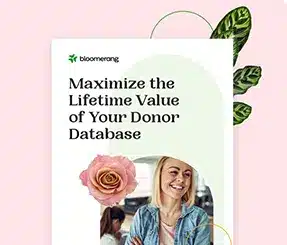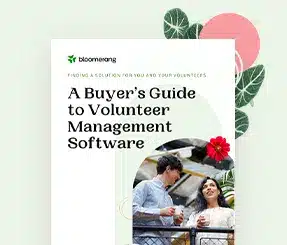Effective Donor Management: 7 Best Practices for Nonprofits


Full Platform Overview Chat With Us



Full Platform Overview Chat With Us




Generous donor support keeps your nonprofit’s lights on, allowing you to work toward your mission more efficiently. That’s why it’s critical to have a clear donor management plan. How you engage donors, personalize your interactions with them and show appreciation for them all impacts whether they continue supporting your cause.
In this guide, we’ll look at how you can create a well-rounded donor management approach to support your long-term fundraising strategy and goals. We’ll cover:
Donor management is a multi-faceted process, requiring input from different teams within your nonprofit’s staff. But when all the pieces come together, your nonprofit will benefit from loyal support, increasing your donor retention rate.
Donor management is the steps your nonprofit takes to acquire new donors, collect donor information and use that information to cultivate strong supporter relationships.
Because donor relationships are some of the most important relationships your nonprofit has, it’s important to optimize every stage of the donor management process. Creating a positive experience for your supporters increases the chances that they’ll continue supporting your cause for the long term.
As a nonprofit professional, you know that most donations don’t just appear out of thin air. The donation cultivation process requires consistent outreach and relationship-building efforts to secure ongoing gifts. A dedicated donor management strategy makes it easier to foster consistent support.
Managing and growing donor relationships offers the following benefits to nonprofits:
It may take some time to develop a donor management strategy, but these benefits make it worth the time and effort because they support long-term growth.
It’s helpful to look at the donor management process through the lens of the donor journey or lifecycle. The donor journey is the process by which new supporters learn more about your organization and determine whether they want to donate to your cause.
The four stages of the donor journey are awareness, research, decision and retention. Let’s take a closer look at each phase and how your nonprofit can optimize the donor management process throughout each step.
In the awareness phase, potential new supporters hear about your organization for the first time. This is the stage where you’ll first make contact with individuals who may eventually become donors, meaning it’s crucial to make a positive first impression.
Creating targeted marketing campaigns is the most effective way your organization can manage potential donors at this stage. There are plenty of ways you might reach new supporters for the first time, including through:
The more touchpoints you can have with potential new donors, the more likely you are to catch their attention and spark their interest.
Also, consider developing personalized outreach materials. Studies have shown that 62 percent of consumers who make online purchases said that a brand would lose their loyalty if it delivered a non-personalized experience.
Personalize your outreach by addressing emails and direct mail with recipients’ names or referencing their past involvement with your nonprofit, whether as an event attendee, volunteer or social media follower.
After hearing about your organization, potential new supporters will conduct further research about your cause and your mission. In this phase, it’s important to ensure your online marketing materials are designed to clearly communicate what your nonprofit does, why it matters and how donor support makes a difference.
To help facilitate the research process, ensure the following marketing platforms are optimized to spread information about your mission:
Ultimately, your goal should be to make it easy for new audience members to understand your organization on a deeper level in just a few minutes by looking at any of your digital marketing platforms.
In this stage, new audience members decide whether they want to show their support and donate to your cause.
Offer multiple ways for donors to give depending on their preferences, including:
Once donors decide they want to give, you want to ensure your donation processes are as straightforward as possible. This increases the chances that donors will follow through on their intention to give and feel more inclined to donate again in the future.
The donor journey doesn’t end once an individual has donated. In the ongoing stewardship and retention phase, your nonprofit must work to stay engaged with donors, cultivate stronger relationships and ultimately encourage them to become recurring donors.
There are three aspects of the retention process:
By carefully managing and cultivating donor relationships, you can make the donor journey a cyclical process and promote more recurring gifts.
Next, we’ll dive into some tips and best practices for optimizing your donor management at every stage of the donor journey.
As you streamline each step of the donor lifecycle, there are several tips, best practices and tools you can use that will help simplify the donor management process.
Setting donor management goals can give your nonprofit’s team an objective to strive for that will guide all of your donor outreach efforts. Your goals should be SMART: specific, measurable, attainable, relevant to your organization’s overall mission and time-based.
Set an overall donor management goal for your organization each year as well as goals for every campaign. For example, you might set yearly goals to acquire 200 new donors or increase your donor retention rate to 50%. Then, you might set smaller goals for your peer-to-peer fundraising campaign, such as recruiting at least 50 volunteer fundraisers or calling every person who gives to the campaign to say thank you.
Determine quantifiable metrics to assess your donor management progress. These metrics should be relevant to your goals. For example, you might track donor engagement analytics such as:
You can use several tools and resources to identify and analyze these metrics, including your:
Work with your team to determine which metrics you’ll track, when you’ll report on each metric and who is responsible for updating each metric. View metrics reports regularly to understand what’s going well and which areas of your donor management approach need improvement.
A donor management system is a software tool that allows nonprofits to store, organize and report on supporter data. You may have also heard this platform referred to as a nonprofit CRM.
Investing in powerful donor management software offers many benefits. This tool allows nonprofits to:
It’s important to look for robust donor management software that offers a wide variety of features to meet your nonprofit’s needs. Typically, it’s better to look for a more robust system upfront that can grow alongside your nonprofit rather than sticking with an inexpensive but less built-out option.
Every donor management system will look slightly different, but there are a few must-have features to seek out if you’re looking to invest in a new solution. Look for software with these features:
For example, Bloomerang is a top donor management platform that offers these essential features, plus additional special tools like a generosity and engagement score to identify your most engaged donors who are likely to level up their giving. Learn more about Bloomerang’s platform here:
Schedule demos with your top options to get an idea of what the software looks like in action. Ensure your solution offers training and support to make the implementation process as smooth as possible.
Donors want to know that their gifts actually made a difference for your cause. Seeing the impact of their donations first-hand can encourage them to continue giving.
In your donor communications, share progress updates on how donations have helped you achieve a goal, complete a project, fund a program or work toward another objective. Include photos that demonstrate progress, such as photos of your volunteers sorting thousands of food items using your new equipment or images that show the construction of your new facility.
You can send emails with branded donor recognition eCards that include statistics about the impact of donor support and images of your mission in action. You might even recruit volunteers or community members to write thank you messages to donors letting them know the impact their gifts have had on them personally. Both of these outreach methods can build a strong emotional connection with your donors and encourage long-term giving.
Using the information in your donor database, you can segment supporters based on their shared interests or behaviors, creating smaller donor groups. Then, you can create tailored content for each group rather than sending generic, one-size-fits-all messages to your entire donor base.
You can segment donors based on a variety of criteria, including:
Segmentation is an effective way to create more personalized outreach content while still saving your team time. Donors will appreciate your efforts to send messages that align with their interests and motivations. As a result, you’ll start to see increased engagement and a higher ROI for your marketing efforts.
Your donor information is only valuable if it’s accurate and complete. With accurate donor information, you can rest assured that you’re sending marketing messages to the right addresses, phones and emails. This will increase your marketing ROI since you won’t waste time and effort sending messages to incorrect addresses or phone numbers.
To ensure that your data stays clean and updated, implement a data hygiene process for your team to follow when inputting and updating the information in your database. Ensure your data hygiene procedures include these steps:
It’s helpful to find donor management software that completes these processes automatically. For instance, Bloomerang’s donor management system performs automatic daily updates for information such as birthdays, addresses and donor wealth information. This can save your team’s time and help ensure your records are as accurate and comprehensive as possible.
As you carry out your donor stewardship efforts, it’s important to strike the right communication balance. You don’t want to flood your donors’ inboxes. However, you don’t want to fall off their radar and have them forget you, either.
Creating a communication cadence can be a helpful way to ensure you’re engaging with donors regularly without overwhelming them. Your cadence might start with a thank-you email after a donor gives for the first time. Then, you may send several additional messages spread over a few months.
Using a multichannel outreach strategy allows you to have multiple touchpoints with donors that feel fresh and unique. Consider using the following platforms as part of your multichannel communications:
Use your communications to highlight additional ways to engage that don’t involve donating, such as volunteering or attending events. This shows supporters that you value all kinds of support, not just donations. Plus, when donors participate in these opportunities, they may feel a stronger connection to your cause, encouraging them to stay involved for the long haul.
As you can see, donor management takes time and careful planning to cultivate long-lasting supporter relationships. Using robust donor management software and marketing tools makes the process easier, helping you keep all donor management activities under the same roof.
Ultimately, effective donor management is about using the information you have about your donors to personalize your interactions with them and create a better experience. For more information on optimizing your donor management approach, check out these additional resources:
Comments
Mark